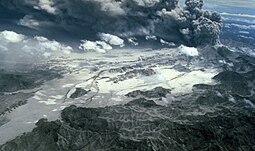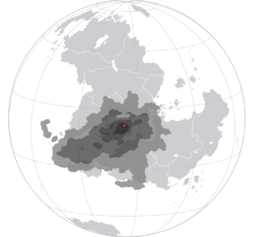2020 eruption of Mount Micchiano
This article is incomplete because it is pending further input from participants, or it is a work-in-progress by one author. Please comment on this article's talk page to share your input, comments and questions. Note: To contribute to this article, you may need to seek help from the author(s) of this page. |
| 2020 eruption of Pico de Sangue | |
|---|---|
 Pyroclastic flow runs down the southern cliff of Pico de Sangue, 16 September 2020 | |
| Start date | September 15, 2020 |
| End date | October 8, 2020 |
| Location | Pico de Sangue, Vasconha Town, Demora Province, Maracao |
| VEI | 6 |
| Impact | large scale loss of life, mass destruction of property, significant economic devastation |
| Deaths | 40,000–80,000 (est.) |
 Map detailing the quantity of ash fallout due to the eruption across Asterias Superior and Inferior | |
The 2020 eruption of Pico de Sangue occurred at the the Pico de Sangue volcano in central Maracao between September 15 and October 8, 2020. The phreatomagmatic eruption measured a 6 on the Volcanic Explosivity Index, the largest in modern Maracan history and one of the largest eruptions recorded in recent years. Over the course of 23 days, large scale destruction across Maracao occurred as a direct result of the eruption, including pyroclastic flows, lahars, and extensive volcanic plumes that massively disrupted economic activity across the entire Arucian. With around 40,000 to 80,000 casualties estimated as a direct result of the eruption, including nearly 25,000 when Guajaratuba was hit by a pyroclastic flow, it is the deadliest natural disaster in recent Asterian history. The disaster was followed by a transnational aid effort that included contributions from the AIS, ASTCOM, COMSED, the Euclean Community, NVO, ROSPO as well as contributions by CoN-affiliated aid commissions.
Widespread economic disruption arose from large-scale deposits of fine ash that were blown across the Arucian Sea. Among the worst affected countries were Maracao itself, Imagua and the Assimas, Aucuria, Sainte-Chloé, Nuvania and Eldmark. Disruption to trade and tourism was extensive from flights that were grounded for almost a month, and sea-based travel was also made less frequent due to the ash. Agriculture suffered as livestock were killed by ash inhalation and consumption, and the region entered a large-scale economic recession following the eruption. Production of tropical goods such as tobacco, citrus, bananas, pineapples, avocadoes, mangoes, nuts and chilis. Maracao's real GDP growth for 2020 was the lowest since the Sugar Crash, and in much of the Arucian it was the most significant recession since the 2005 global financial crisis.